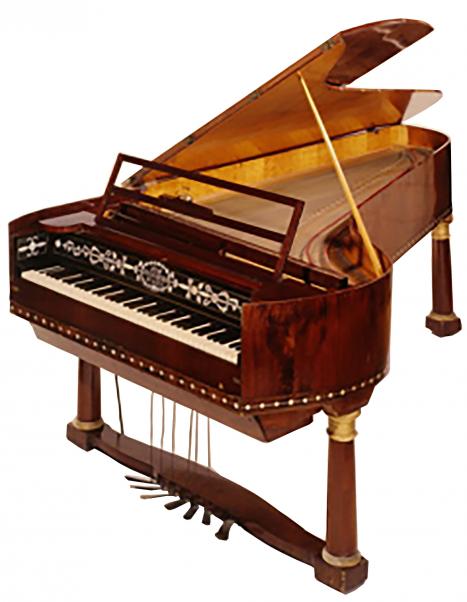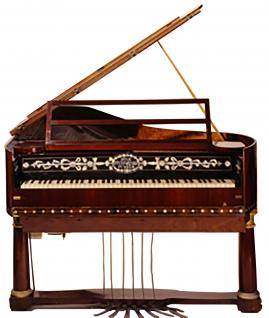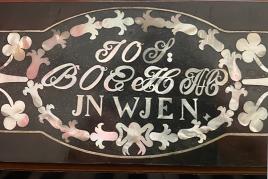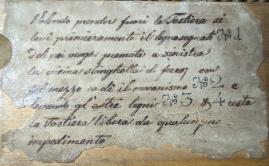grand piano joseph böhm (1786-1848)
Vienna ca. 1821 or following years.
Currently, the only surviving grand piano with additional organ rank of this era.
Mechanics: Viennese action
Range:
6 octaves + fourth, 78 keys (C₁-f4)
Levers, Pedals: Pedals (from left to right):
Organ on, Pianoforte off, bassoon, moderator, dampers, Janissary (with "Drum"+ 3 bells), organ bellows
Stringing:
Brass: C₁ -F
Iron: F#-f 4
Organ pipes from f 0 to f 4
Signature:
„JOS: // BOEHM // IN WIEN“ (ornamental mother-of-pearl inlay); in the soundboard Ms.: „Joseph Boehm in Wien Clavier No 804“.
Special features:
Handwritten instructions for the disassembly of the mechanics pasted on the underside, in Italian:
"Volendo prender fuori la Tastiera si // levi primieramente il legno segnati
No 1 // ddi poi senghi premuta a sinistra // la vicina stanghella di ferro;
con // del mezzo cadè il mecanismo No 2 e // levando gl'altre legni No 3 &
4 resta // la Tastiera libera da qualunque // impedimento"




Joseph Boehm publicly presented the construction with an integrated organ stop around 1821. In addition to this organ rank "Querflöte/Wienerflöte" with a range of f0-f4, this piano also features the following modifications: organ on, pianoforte off, bassoon, moderator, damper lift, Turkish battery ("drum" = a bar striking across the lowest strings plus soundboard, 3 small bells), bellows pedal.
Joseph Böhm (1786-after 1841) trained as a piano maker starting in 1811
and opened his own workshop two years later. He received several 5-year
privileges/patents, including one in 1821 for a music stand with a
foot-operated page-turning device, and also in 1821, for a pianoforte
with organ stops.
Since this body shape with rounded corners fell
out of fashion around 1830 in favour of a comparatively distinctly
angular shape, it is likely that this instrument originated in the 1820s.

"In 1821, the piano maker Jos. Böhm in Vienna completed a pianoforte that is connected to a 5½-octave flute rank, with the pipes lying horizontally at the bottom of the pianoforte, allowing either one or the other to be played alone or both together." (from: Stephan Edler von Keeß: Beschreibung der Fabricate, welche in den Fabriken, Manufacturen und Gewerben des österreichischen Kaiserstaates erzeugt werden, Wien 1823 II, S. 199)
Böhm was considered one of the most innovative piano builders of his time. In fact, some of his ideas are quite practical, though not necessarily new, such as his music page-turner, a transposition keyboard, an attached pedal keyboard, or his fortepianos "with flute organs." To what extent all of these inventions were actually in demand and whether they proved to be impractical or simply too expensive is not known.



